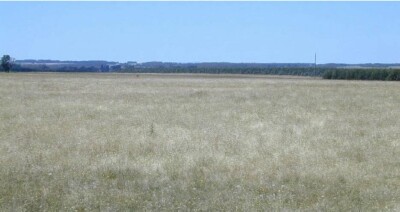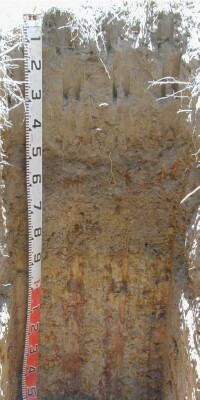JEE98 (Plot 3)
| Site: JEE98 (Plot 3) | Land Unit: Dundas Redgum |
| Aust. Soil Class.: | |
 | General Land Unit Description: The flat surface of the Dundas Tablelands predominantly consists of Brown Chromosols and to a lesser extent Yellow Chromosols with a ferric horizon, typically occurring above the clay subsoil. The soil is commonly developed over a highly weathered mottled zone. This red and white mottling, sometimes referred to as ‘tiger mottles’, is thought to be the result of deep chemical weathering which occurred during the late Tertiary period. Red gums are the dominant vegetation found on this surface. Two year old Eucalyptus globulus plantation on ex-agricultural land. |
Site Description:
| Geology: Cainozoic duricrust | Landform pattern: Gently undulating plains |
| Position in landscape: Flat | Internal drainage: Imperfectly drained |
Soil Profile Morphology
| A1 | 0-20 cm | Dark grey (10YR4/1) sandy loam; weak polyhedral structure (10-20 mm) parting to single grain structure; very weak consistence when dry; many medium roots; clear and smooth transition to: |  |
| A2 | 20-40 cm | Pale brown (10YR6/3) sandy loam; weak polyhedral structure (20-50 mm) parting to single grain structure; very weak consistence when dry; many medium roots; clear and smooth transition to: | |
| Subsoil | |||
| Bs | 40-85 cm | Light yellowish brown (10YR6/4) sandy loam; unable to assess structure, consistence and macroporosity due to presence of very many segregations; moderately moist; very many coarse ferruginous nodules; few very fine roots; abrupt and wavy transition to: | |
| B21 | 85-150 cm | Light grey (10YR7/2) with many medium distinct yellowish brown (10YR5/6) and yellowish red (5YR5/6) mottles, light medium clay; moderate polyhedral structure (20-50 mm) parting to moderate polyhedral structure (5-10 mm); firm consistence when moderately moist; few coarse ferruginous soft segregations; common subrounded tabular large pebbles (sandstone); common very fine macropores; areal porosity 0. 1%; no roots observed. | |
| 150-340 cm | Heavy grey clays with red and yellow mottling, ferruginous cemented sandstone fragments increasing with depth, remnant roots observed to 340 cm, probably not an impeding layer, but water holding capacity may be reduced. |
Sampled by: Ian Sargeant, Paul Feikema and Kiet Quach (7 December, 2000).


